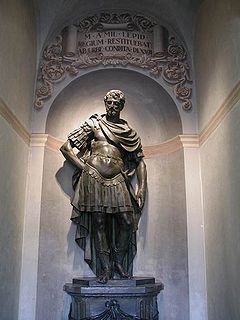Gaius Flaminius can refer to:
Gaius Flaminius can refer to:

Quintus Fabius Maximus Verrucosus, surnamed Cunctator, was a Roman statesman and general of the third century BC. He was consul five times and was appointed dictator in 221 and 217 BC. He was censor in 230 BC. His agnomen, Cunctator, usually translated as "the delayer", refers to the strategy that he employed against Hannibal's forces during the Second Punic War. Facing an outstanding commander with superior numbers, he pursued a then-novel strategy of targeting the enemy's supply lines, and accepting only smaller engagements on favourable ground, rather than risking his entire army on direct confrontation with Hannibal himself. As a result, he is regarded as the originator of many tactics used in guerrilla warfare.
This article concerns the period 229 BC – 220 BC.
This article concerns the period 29 BC – 20 BC.
This article concerns the period 219 BC – 210 BC.

Year 217 BC was a year of the pre-Julian Roman calendar. At the time it was known as the Year of the Consulship of Geminus and Flaminius/Regulus. The denomination 217 BC for this year has been used since the early medieval period, when the Anno Domini calendar era became the prevalent method in Europe for naming years.

Gaius Flaminius was a leading Roman politician in the third century BC. Twice consul, in 223 and 217, Flaminius is notable for the Lex Flaminia, a land reform passed in 232, the construction of the Circus Flaminius in 221, and his death at the hands of Hannibal's army at the Battle of Lake Trasimene in 217, during the Second Punic War. Flaminius is celebrated by ancient sources as being a skilled orator and a man possessed of great piety, strength, and determination. He is, however, simultaneously criticised by ancient writers such as Cicero and Livy for his popular policies and disregard of Roman traditions, particularly during the terms of his tribunate and second consulship.

Marcus Aemilius Lepidus was a Roman consul, Pontifex Maximus, Censor and Princeps Senatus. A scion of the ancient Patrician gens Aemilia, he was most likely the son of Marcus Aemilius Lepidus, with his brothers being Lucius and Quintus.
Cassius Longinus may refer to:
Novus homo or homo novus was the term in ancient Rome for a man who was the first in his family to serve in the Roman Senate or, more specifically, to be elected as consul. When a man entered public life on an unprecedented scale for a high communal office, then the term used was novus civis or "new citizen".
Gaius, sometimes spelled Gajus, Cajus, Caius, was a common Latin praenomen; see Gaius (praenomen).
Tiberius Sempronius Longus was a Roman consul during the Second Punic War and a contemporary of Publius Cornelius Scipio. In 218 BC, Sempronius was sent to Sicily with 160 quinqueremes to gather forces and supplies, while Scipio was sent to Iberia to intercept Hannibal. It was at this time, striking from Lilybaeum, on the island of Sicily, that Sempronius Longus captured Malta from the Carthaginians.
Gaius Flaminius was Roman consul in 187 BC, together with Marcus Aemilius Lepidus. During his consulship, he fought to pacify Ligurian tribesmen who had been raiding northern Italy.
Marcus Atilius Regulus, a son of Marcus Atilius Regulus, the consul captured during the First Punic War, and a grandson of Marcus Atilius Regulus, was a Roman consul for the year 227 BC, together with Publius Valerius Flaccus, and was a consul suffectus in 217 BC, replacing Gaius Flaminius, who was killed in battle at Lake Trasimene.
Gnaeus Servilius Geminus was a Roman consul, serving as both general and admiral of Roman forces, during the Second Punic War.
Publius Furius Philus was a consul in 223 BC, a praetor in 216, and a censor in 214. He died the following year, before resigning his office.
Flamini or variations may refer to:
Gaius Atilius Regulus was one of the two Roman consuls who fought a Celtic invasion of Italy in 225-224 BC; he was killed in battle and beheaded. Atilius came from a prominent family of consuls for four generations; the family originally hailed from southern Italy.
The gens Flaminia was a plebeian family at ancient Rome. During the first five centuries of Rome, no mention is made of any member of the Flaminia gens. In former times the Flaminii were believed to be only a family of the Quinctia gens; but this opinion arose from a confusion of the Flaminii with the Flaminini, the latter of whom belonged to the ancient patrician Quinctia gens.
Gaius Centenius was a propraetor of the Roman army. He fought at the Second Punic War, and was defeated at the Battle of Lake Trasimene.